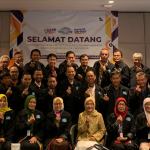Quirky GIF Portraits Indulge a Photographer’s Need for Spontaneity
The committee-driven and regulated world of advertising photography can be a constraining force on the creative mind. After moving to New York and picking up ad work, Romain Laurent was itching for a more spontaneous outlet. He started One Loop Portrait a Week as a way to satisfy his urge to improvise and get a break from the second-guessing that creeps into even personal projects as they get “serious.”
“Early in my photography days, it was just about taking a photo, and by the evening I had it done and it was online,” he says. “So my idea with this project was to try to find that spark again, the kind of creative rhythm or energy that you have when you’re younger.”
Featuring mostly friends and acquaintances, many of the portraits are built as Cinemagram-style combinations of still and animated elements within the same image. Choosing a base image from the filmed sequence, he then carefully overlays the animated elements from the rest of the video so that they seamlessly move in the still picture.
Next he painstakingly cleans up the frames between the areas of stillness and motion, and uses tricks like reversing loops so that an obvious recycle point doesn’t break the illusion. Certain textures like water can make the task especially challenging.
“In all my work I like to play with people’s ‘wait, what?’ moment.” he says. “I feel this is a perfect medium to be silly.“
The GIF (we at Raw File cannot bring ourselves to say ‘JIF’) is often seen as a throwaway format, reserved for cute cats doing un-catly things. But the wave upon wave of the same sequence of images invites viewers to read between the frames. This makes them an ideal format for economical-yet-compelling portraits.
“It’s a portrait where you actually get something out of the person through their movement,” says Laurent.
Last month, WIRED got a chance to participate in the GIF portraiture process at Laurent’s Brooklyn studio. Keeping the shoots lean and quick, Laurent begins with the simplest seed of an idea, and indulges any notion that crosses his or his subject’s mind, until it either produces an interesting image or falls flat. He experiments with different angles, lighting, and variations on the portrait’s concept until there is a minute or two of usable footage to work with. It’s then a short hop to the computer where he begins picking at it to find an intriguing three to five-second snippet. On this visit, Laurent’s recent interest in learning new tricks with post-production software meant the portrait would feature a spooky trailing effect.
Key to the process is the lack of a formal structure or plan, and the resulting freedom from worrying about a “perfected” final product. “It’s just going along with what goes through my mind and doing it, and not caring about the scale of the project,” he says.
As his first ongoing effort now more than two months running, Laurent encourages his subjects to add their own creative ideas, helping to produce a unique portrait every time. The rapid-fire exchange of ideas yields a variety of distinct film snippets which he can scour for loop-worthy moments — it also means he doesn’t know what he’ll get before he sees it.
“With that I keep some kind of ‘dangerous’ side to it, which is letting it happen — maybe it will or maybe it won’t,“ he says, adding that the improvisational nature of the process often gets both sides excited. “It makes me happy, I have to say.”
Laurent’s personal projects are generally more involved, and although free of the demands of advertising clients, they still require long hours of detailed review before they’re finished and released for posterity.
“With the other ones, I think about it a lot, then I talk to several people who will work on it with me, then I shoot it over two or three days, and then retouch it. With this one, I just put myself out there and I let people react, and allow myself the risk of being influenced, or to be excited about the feedback.”
Before the final click, Laurent tries to choose a funny caption to round out each portrait, taking inspiration from Far Side mastermind Gary Larson. After that, the project marches on.
“I have no right to go back to it, even if nobody will say anything if I delete it — in my mind, its done if it’s posted online,“ he says. “I put it out just to have closure with it, to not dwell on it and move on to the next one.”







Recent Comments